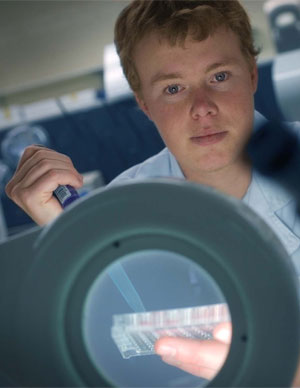 Topics Topics |
|
|
|
 Species Species |
|
|
|
|
|
Pulse v bulge: grain legumes offer hope in obesity battle
Australia
June 13, 2013
An Australian research student has discovered potential anti-obesity properties in pulses such as chickpeas, faba beans and field peas.

Funded by the Grains Research and Development Corporation (GRDC), Charles Sturt University student Kyle Reynolds has found that compounds in pulses (grain legumes) appear to stop adult mouse stem cells from developing into fat cells and inhibit the absorption of fat during digestion.
Mr Reynolds said these results could now be used to determine if pulses have the potential to be used in the treatment or prevention of obesity.
“While this result doesn’t completely explain the anti-obesity effects of pulses, it does go some way to providing a mechanism by which pulses may help us maintain a healthy weight,” he said.
“The findings are also good news for the Australian pulse industry. If it can be further shown that pulses do have the potential to fight obesity, the demand for pulses is likely to increase, boosting the value of the industry and its products. That can only be a good thing for Australian growers.”
During his research at CSU in Wagga Wagga (New South Wales), Mr Reynolds extracted compounds from chickpeas, faba beans and field peas and incubated them with adult mouse stem cells that were being converted to fat cells.
The pulse extracts appeared to inhibit the process of fat cell development (adipogenesis) by turning off a key gene in this process, suggesting that pulses may contain compounds that interact with genes to provide health benefits.
Mr Reynolds also identified that field pea extracts contain compounds that have the ability to inhibit the activity of pancreatic lipase – the enzyme secreted by the pancreas to break down fats in the intestinal tract during digestion.
To provide further evidence, whole animal experiments would be required to determine how compounds from pulse extracts are metabolised in the body.
Mr Reynolds said the potential of natural products in the treatment of obesity was largely unexplored, but recent studies indicated that the inhibition of the processes that lead to fat cell development were associated with the bioactivity of phenolic compounds which are found in plants and vegetables. Phenolic compounds have also been associated with anti-cancer and anti-oxidant activities.
Previous research has shown that other members of the legume family – including garden pea, white kidney bean and fenugreek – exhibited anti-obesity properties. “This provided reason to believe that other related species may exhibit similar anti-obesity activities.”
After demonstrating the anti-adipogenic and anti-obesity of the pulse extracts, Mr Reynolds said the next logical step would be to isolate fractions of the pulse extracts to identify the specific compounds that are responsible for the anti-adipogenic and anti-obesity activities.
“These compounds could then be used in the preparation of pharmaceuticals or in the development of value-added food products, for the treatment or prevention of obesity,” he said.
Mr Reynolds said it was extracts from the seed of pulses that had shown anti-obesity properties during his research, so it would be interesting for experiments to be undertaken on extracts from pulse hulls to determine if they contain similar properties.
“Hulls are normally regarded as a waste product, but if it could be shown that the hulls contain compounds that significantly inhibit the process of adipogenic differentiation, they could potentially be used within the food production industry, through the development of value-added food products.”
To follow on from Mr Reynolds’ investigations, researchers at CSU will now look at extracts from other grains to see if similar results can be obtained.
In the meantime, Mr Reynolds has obtained a PhD scholarship from The Graham Centre for Agricultural Innovation (an alliance between CSU and NSW DPI to integrate and value-add research) and has recently commenced his PhD through CSU, based at CSIRO in Canberra.
Mr Reynolds is one of two honours students training in the area of pulse quality research at CSU through a GRDC-funded capacity building program specifically for the Australian pulse industry.
CSU senior lecturer in food science, Associate Professor Chris Blanchard, leads the project and collaborates with Dr Jenny Wood (NSW DPI) and CSU’s Dr Padraig Strappe and Dr Hassan Obeid.
The second student funded under this project, Michelle Low, is focused on measuring the antioxidant properties of a range of pulse-based products and assessing the impact of cultural cooking practices on antioxidant levels.
Assoc Prof Blanchard said the GRDC-funded program had been established as a means of addressing the lack of suitably qualified people and building capacity specifically for and within the Australian pulse industry.
Pulses provide Australian grain growers with an important crop option. When integrated into the cropping rotation, they can increase soil fertility, improve the yields of following cereal crops and assist in the reduction of soil-borne and stubble-borne diseases.
More news from: GRDC (Grains Research & Development Corporation)
Website: http://www.grdc.com.au Published: June 13, 2013 |
SeedQuest does not necessarily endorse the factual analyses and opinions
presented on this Forum, nor can it verify their validity. |
|
|